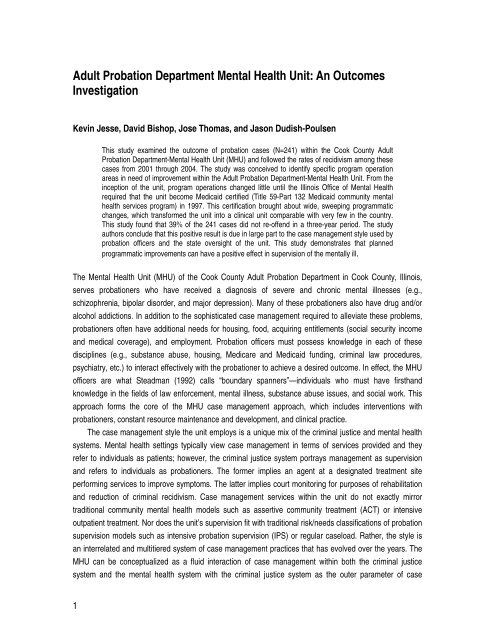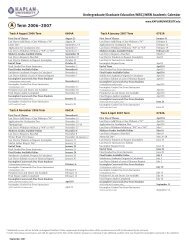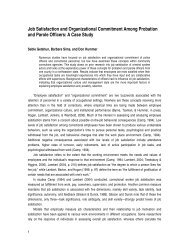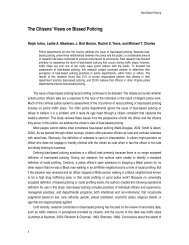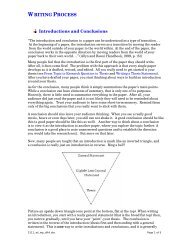Adult Probation Department Mental Health Unit: An Outcomes ...
Adult Probation Department Mental Health Unit: An Outcomes ...
Adult Probation Department Mental Health Unit: An Outcomes ...
- No tags were found...
Create successful ePaper yourself
Turn your PDF publications into a flip-book with our unique Google optimized e-Paper software.
<strong>Adult</strong> <strong>Probation</strong> <strong>Department</strong> <strong>Mental</strong> <strong>Health</strong> <strong>Unit</strong>: <strong>An</strong> <strong>Outcomes</strong>InvestigationKevin Jesse, David Bishop, Jose Thomas, and Jason Dudish-PoulsenThis study examined the outcome of probation cases (N=241) within the Cook County <strong>Adult</strong><strong>Probation</strong> <strong>Department</strong>-<strong>Mental</strong> <strong>Health</strong> <strong>Unit</strong> (MHU) and followed the rates of recidivism among thesecases from 2001 through 2004. The study was conceived to identify specific program operationareas in need of improvement within the <strong>Adult</strong> <strong>Probation</strong> <strong>Department</strong>-<strong>Mental</strong> <strong>Health</strong> <strong>Unit</strong>. From theinception of the unit, program operations changed little until the Illinois Office of <strong>Mental</strong> <strong>Health</strong>required that the unit become Medicaid certified (Title 59-Part 132 Medicaid community mentalhealth services program) in 1997. This certification brought about wide, sweeping programmaticchanges, which transformed the unit into a clinical unit comparable with very few in the country.This study found that 39% of the 241 cases did not re-offend in a three-year period. The studyauthors conclude that this positive result is due in large part to the case management style used byprobation officers and the state oversight of the unit. This study demonstrates that plannedprogrammatic improvements can have a positive effect in supervision of the mentally ill.The <strong>Mental</strong> <strong>Health</strong> <strong>Unit</strong> (MHU) of the Cook County <strong>Adult</strong> <strong>Probation</strong> <strong>Department</strong> in Cook County, Illinois,serves probationers who have received a diagnosis of severe and chronic mental illnesses (e.g.,schizophrenia, bipolar disorder, and major depression). Many of these probationers also have drug and/oralcohol addictions. In addition to the sophisticated case management required to alleviate these problems,probationers often have additional needs for housing, food, acquiring entitlements (social security incomeand medical coverage), and employment. <strong>Probation</strong> officers must possess knowledge in each of thesedisciplines (e.g., substance abuse, housing, Medicare and Medicaid funding, criminal law procedures,psychiatry, etc.) to interact effectively with the probationer to achieve a desired outcome. In effect, the MHUofficers are what Steadman (1992) calls “boundary spanners”—individuals who must have firsthandknowledge in the fields of law enforcement, mental illness, substance abuse issues, and social work. Thisapproach forms the core of the MHU case management approach, which includes interventions withprobationers, constant resource maintenance and development, and clinical practice.The case management style the unit employs is a unique mix of the criminal justice and mental healthsystems. <strong>Mental</strong> health settings typically view case management in terms of services provided and theyrefer to individuals as patients; however, the criminal justice system portrays management as supervisionand refers to individuals as probationers. The former implies an agent at a designated treatment siteperforming services to improve symptoms. The latter implies court monitoring for purposes of rehabilitationand reduction of criminal recidivism. Case management services within the unit do not exactly mirrortraditional community mental health models such as assertive community treatment (ACT) or intensiveoutpatient treatment. Nor does the unit’s supervision fit with traditional risk/needs classifications of probationsupervision models such as intensive probation supervision (IPS) or regular caseload. Rather, the style isan interrelated and multitiered system of case management practices that has evolved over the years. TheMHU can be conceptualized as a fluid interaction of case management within both the criminal justicesystem and the mental health system with the criminal justice system as the outer parameter of case1
management. All cases assigned to the unit have a mental health mandate from the court, which requiresprobationers to participate in mental health treatment. Additionally, the court may impose other specialconditions on the probationer such as no contact with victim, random urinalysis testing, and payment offees. The MHU adheres to phases as a method of supervision/case management. The phases provide astructured reporting requirement for probationers. Additionally, fieldwork is another component of policy thatrequires officers to engage probationers in their community, make resource contacts, and speak with familymembers.The relationship between MHU probation officers and probationers is delicate and complex. The MHUphilosophies (care and intervention versus surveillance) and the treatment options available to probationersinfluence treatment implementation and criminal activity outcomes (Skeem, Encandela, & Eno Louden,2003). This study sought to understand the long-term outcomes of 241 probation cases within the MHU,specifically, the recidivism rate of probation cases terminated in 2001, along with understanding how theeffects of treatment can have positive outcomes (e.g., remaining mentally stable and arrest-free throughappropriate treatment) of mentally ill probationers. <strong>Unit</strong> managers can use the information gained from thisstudy to improve the unit’s effectiveness while helping to make the unit a model for other correctionaldepartments dealing with the mentally ill.Literature ReviewIn 1999, the U.S. <strong>Department</strong> of Justice, Bureau of Justice Statistics estimated that mentally ill peoplecomposed 16.0% of the American prison and jail population. This special report also noted that thepercentage of probationers in the <strong>Unit</strong>ed States who were mentally ill was similar (16%). Slightly more thanone half (56%) of these probationers but less than one half (41%) of the jailed probationers receivedtreatment for their mental illnesses (Ditton, 1999). The failure to identify and treat the mentally ill who enterthe criminal justice system perpetuates a cycle of symptomatic behavior, substance abuse, homelessness,and arrests (Lurigio & Swartz, 2000; Lurigio, Thomas, & Jones, 1996; Teplin, 1990). This pattern becameestablished after the shift in public policy from the institutionalization of persons with mental illness to theirrelease for treatment in the community. Although state hospitals had been ridiculed as inadequate, sufficientcommunity-based care for the mentally ill was never established (Lurigio & Swartz, 2000). Lurigio et al.(1996) point out that patients without family and employment, or whose mental illness was poorly controlledby prescribed drugs, faced homelessness and criminal incarceration.Diagnostic LimitationsDue to this unintended use of the criminal justice system for the management of mentally ill persons, theircontact with service providers who can make diagnoses and provide treatment may be delayed, limited, orfail to occur (Lurigio, Fallon, & Dincin, 2000; Teplin, 1990). The priorities of the criminal justice system differfrom the mission of treatment agencies. By necessity, the criminal justice system must focus primarily onpublic safety and probationer supervision rather than the provision of social services. For this reason,mental health assessments and treatments are often unavailable to criminal probationers. These problemsare compounded for mentally ill probationers with substance abuse problems. Current methods for theassessment of substance abuse were not designed for use with mentally ill persons. They are inadequate2
screens for this condition due to patterns of use and treatment processes that differ from those of personswho are not mentally ill (Wolford et al., 1999).Treatment of the NoncompliantA number of individual, societal, and systematic factors contribute to treatment noncompliance amongmentally ill probationers. They include lack of entitlements, homelessness, poverty, poor insight into theirillnesses, medication noncompliance, substance abuse, and lack of access to dual diagnosis treatment. Inworking with probationers, the <strong>Mental</strong> <strong>Health</strong> <strong>Unit</strong> helps negotiate each barrier to reduce the chance fornoncompliance, particularly for two factors: the loss of entitlements and medication noncompliance.<strong>Probation</strong>ers experience a discontinuation of benefits when they are incarcerated. Once released theprobationer must see a psychiatrist again and start a regimen of psychotropic medications. Many psychiatricmedications cause side effects such as facial tics, blurred vision, dry mouth, slurred speech, rapid weightgain, and slowed gait. These side effects cause discomfort and make the probationer less likely to continueuse of these medications. <strong>Probation</strong>ers often tell MHU officers that these side effects make other peoplereact differently to them and cause them to isolate themselves from others. If the medications alleviate somesymptoms, probationers may think they can stop the medications and maintain their current functioning. Atthat point, the probationer might require hospitalization to control symptom renewal.Issues of Substance AbuseSubstance abuse has become an increasingly more significant factor in the mentally ill probationer’snoncompliance with treatment and probation. Hartwell (2003) states that living in the community with thedouble stigma of mental illness and a criminal background is problematic for many probationers. High ratesof substance abuse among this population compound the issues related to helping those with mental illness(Draine & Solomon, 1994; Solomon & Draine, 1999a; Swanson, Borum, & Swartz, 1996). As this studyshows, 70% of the MHU census was classified as having a dual diagnosis (co-occurring mental illness andsubstance use disorder). It has become more and more important that each MHU officer be, first, familiarwith the drug culture and then proficient in working with probationers with these dual diagnoses. Weencounter mentally ill probationers in differing stages of their addiction (relapse, sobriety, maintenance,binge using, etc.), and our experience has shown us that we must intervene before they are arrested on arelated offense, decompensate, and need to be hospitalized. One option is facilitating admission todetoxification and inpatient dual diagnosis treatment. One of the barriers we have encountered is drugtreatment facilities that have few available dual diagnosis beds or few staff who can deal effectively with thedual diagnosis. A probationer must be stable enough to participate in the treatment environment. Somefacilities require psychiatric clearance before an admission, which poses another barrier to addictiontreatment. A probationer with a dual diagnosis may be slightly symptomatic, and believing the probationerwould be disruptive, substance abuse professionals might deny that individual entry into treatment. Theseissues hinder access to those who need these services at such a critical time.Methods3
This study examined the long-term outcomes of each offender terminated from the Cook County <strong>Adult</strong><strong>Probation</strong> <strong>Department</strong>-<strong>Mental</strong> <strong>Health</strong> <strong>Unit</strong> in 2001. Data were collected from probation records and the LawEnforcement Administrators Data System (LEADS). The probation data consisted of case history, recordsheet, felony or misdemeanor arrest records, and mental health intake assessment. The mental healthsection assessment included a description of symptoms, drug and alcohol history, current mental status,prior psychiatric history, medications (current and past), social history, and social entitlements. It alsoincluded medical records that were obtained by the officer from previous treatment providers. Theculmination of the information gathered in the mental health assessment results in the probationer receivinga clinical diagnosis from one of the MHU officers guided by the American Psychiatric Association’sDiagnostic Statistical Manual of <strong>Mental</strong> Disorders, 4 th edition (1994), or DSM IV.A LEADS response was conducted on the 241 cases that terminated in 2001 to see whether any newarrests or convictions had been recorded. In the event of an arrest, the LEADS response was carefullyreviewed to determine whether the arrest was a misdemeanor or felony arrest. These arrest types were thengrouped into specific crime activity categories by specifying the type of crime that was committed.Population Size and Sample SelectionThe sample comprised 241 probationers whose cases were screened for eligibility or directly mandated tothe MHU. The eligibility criterion was probationers with mental illness, both chronic and severe. Table 1 liststhe mental health diagnoses of the participants in this study.Table 1. Primary <strong>Mental</strong> <strong>Health</strong> Diagnoses of <strong>Probation</strong>ersPrimary diagnosisNumber of <strong>Probation</strong>ersPercent(n)Schizophrenia 57 24%Major Depressive Disorder 49 20%Bipolar Disorder 44 18%Schizoaffective Disorder 34 14%Alcohol/Drug Dependence 1 0.4%Learning Disorder/Dementia 2 0.8%Other Diagnosis 25 10%Missing data 29 12%Total 241 100%Note. Missing data is defined as probationers that have either been incarcerated in prison, have absconded,and are deceased. This means the probationer’s assessments were considered incomplete due to theabove circumstances.The first phase of the study also found that 82% of probationers had felony convictions; misdemeanorconvictions totaled 17%. The Bureau of Justice Statistics (U.S. <strong>Department</strong> of Justice, 2004) reported thetotal number of adults sentenced to a term of probation in the <strong>Unit</strong>ed States totaled 49% for felonyconvictions and 50% for misdemeanor convictions. These notable differences suggest that MHU officersdeal with a very difficult population. Supervising the vast majority of the MHU probationers involves a deepunderstanding of the criminal justice system as well as mental health issues.Table 2. Primary Charge: Offenses/Convictions Affecting Sentencing <strong>Outcomes</strong>4
OffenseNumber of Percent<strong>Probation</strong>ersDelivery/Possession of a Controlled Substance 73 30.3%Theft/Forgery/Fraud 39 16.2%Burglary/Possession of a Stolen Motor Vehicle 26 10.8%Aggravated Robbery 12 5.0%Threatening/Obstructing/Resisting a Public Official 2 0.8%Stalking 2 0.8%Assault/Battery 7 2.9%Aggravated Assault/Battery 21 8.7%Domestic Assault/Battery 17 7.1%Unlawful Possession/Use of a Weapon 6 2.5%Arson/Aggravated Arson 4 1.7%Vandalism 3 1.2%Trespassing 1 0.4%Other 28 11.6%Total 241 100%Variables and Data Collection ProceduresIn the first phase of the study, we chose the following variables in a case to measure a probationer’soutcome:• Age at time of sentencing,• Sex and race,• Length of sentence,• Primary charge,• Class of offense,• Dual diagnosis or mental illness diagnosis only• Primary diagnosis,• Primary substance abused,• Number of violations of probation (technical violations and new arrests),• Residence at termination (including type of residence at termination),• Number of jail stays while on probation,• Type of termination, and• Whether transferred from other probation units to the MHU.We collected the majority of the information from a review of the adult probation case data sheets.Other data was collected from mental health assessments and medical records.Some variables require further definition. The primary charge was broken down into 13 varied offensesplus an additional category (Other) (see Table 2). These offenses could have been categorized into drugoffenses, property offenses, and assaultive (physically or verbally) offenses; however, categorizing theseoffenses into 14 separate ones gives a detailed view of the probationer’s arrest.This study reviewed whether a probationer had a dual diagnosis and what the primary diagnosis was.We determined a probationer’s primary diagnosis by reviewing the probationer data sheet and the unit’smental health assessment (intake). The DSM IV (1994) defines the criteria for primary diagnosis. Thecriteria focused on the major mental illnesses (major depression, bipolar disorder, schizophrenia) andincluded alcohol and drug dependence.5
Data <strong>An</strong>alysisThe variables were analyzed by using SPSS software to examine the probationer characteristics andsentence variables. Descriptive statistics along with ANOVA comparisons were conducted with the use ofthe SPSS software. Demographic characteristics are race, age, prior hospitalization, diagnosis, dualdiagnosis, drug use, sentence type, offense type, and information concerning the index arrest and re-arrest.<strong>An</strong>alysis was done to examine the statistical relationship between these variables.LimitationsOne limitation of this study is that some arrest data were missing either from files or LEADS responses.While this investigation examined probation cases within the MHU of the Cook County <strong>Adult</strong> <strong>Probation</strong><strong>Department</strong>, it did not evaluate a comparison group of other types of specialized probation cases within theCook County <strong>Adult</strong> <strong>Probation</strong> <strong>Department</strong>.ResultsResults of this longitudinal study include analysis of the data from the 2001 study along with data from the2004 investigation.<strong>Probation</strong>er CharacteristicsMost (72%) probationers assigned to the MHU were men. More than one half (58%) were African-Americanand more than one third (36%) were White. Only 5% of these probationers were Hispanic. On average,probationers were hospitalized for mental illnesses six times in their lifetimes. Only 15% of them had neverbeen hospitalized for their mental illnesses. Table 3 shows area of interest in gender diagnoses for theMHU.Table 3. Areas of Interest in Gender Diagnoses of <strong>Mental</strong> <strong>Health</strong> <strong>Probation</strong>ers<strong>Mental</strong> <strong>Health</strong> Diagnosis Gender PercentSchizophrenia Male 31%Female 16%Bipolar Disorder Male 21%Female 20%Schizoaffective Disorder Male 18%Female 10%A larger percentage of White (30%) than African-American (15%) probationers had a diagnosis ofbipolar disorder; however, more African-American (32%) than White (17%) probationers had a diagnosis ofschizophrenia. Comparable proportions of White and African-American probationers had a major depressivedisorder (25% and 22%, respectively) and schizoaffective disorder (15% and 16%, respectively).6
Seventy percent of probationers had dual diagnoses of a mental illness and substance abuse. Nosignificant differences existed between men and women in this regard. However, a greater proportion ofAfrican-American (77%) than White probationers (59%) had both these conditions. The primary substancesof choice for this group of probationers were alcohol (28%) and cocaine or crack cocaine (31%). In addition,21% of these probationers preferred marijuana, while 8% of them had a heroin addiction. Table 4 showsarea of addiction for the MHU probationers.Table 4. Areas of Addiction for <strong>Mental</strong> <strong>Health</strong> <strong>Probation</strong>ersSubstance Gender PercentAlcohol Male 34%Female 15%Marijuana Male 24%Female 15%Cocaine/Crack Cocaine Male 30%Female 36%Greater proportions of White (46%) than African-American (21%) probationers were addicted to alcohol.Instead, a greater percentage of African-American than White probationers abused cocaine or crackcocaine (36% and 17%, respectively) or marijuana (26% and 12%, respectively).Most of the probationers (82%) were sentenced for felonies, but 18% received probation sentences formisdemeanors. Almost one third (30%) of the probationers were convicted of a drug offense. The sameproportion (30%) had committed a violent offense. In addition, more than one fourth (27%) of theprobationers were convicted of burglary, theft, forgery, fraud, or possession of a stolen motor vehicle.A greater proportion of women (91%) than men (79%) were sentenced for felonies, but comparableproportions of men and women committed the various types of crime. A higher proportion of African-American (89%) than White (72%) probationers were convicted of felonies. Table 5 gives an itemization ofcertain types of crimes the MHU deals with.Table 5. Types of Crimes of Which <strong>Mental</strong> <strong>Health</strong> <strong>Probation</strong>ers Were Found GuiltyTypes of Crimes Race PercentViolent Crimes White 22%African-American 22%Drug Offenses White 17%African-American 41%Theft/Forgery/Fraud White 25%African American 12%Burglary/Possession of a Stolen Auto White 6%African American 11%Not surprisingly, a greater percentage of probationers with dual diagnoses (42%) than solely mentally illprobationers (12%) were serving sentences for drug offenses; however, a larger proportion of solelymentally ill probationers (33%) than dually diagnosed probationers (20%) had been convicted of violentcrimes.7
Recidivism RatesAs Table 6 shows, the number of new arrests after probation was terminated has significant meaning inrelation to whether the MHU is doing a good job with difficult individuals who are sentenced to probation.The finding that 39% of probationers had no new felony or misdemeanor arrests after probation terminationis a good indication that the MHU deals effectively with the mentally ill.Table 7 shows the gender and race data of MHU probationers re-arrested after termination. Morespecifically, the data show a significant difference in the number of males and females who were re-arrestedin each of the four ethnic groups. In each of the ethnic groups, more males than females were re-arrestedafter probation was terminated. The number of both male and female MHU probationers who were rearrestedafter probation was terminated totaled 42 Whites, 92 African–Americans, 5 Hispanics, and 2 thatwere categorized as Other.Table 6. Number of New Arrests After Termination of <strong>Probation</strong> (from 2004 LEADS Response Data)Number of Arrests Number of <strong>Probation</strong>ers Percent0 93 39%1 44 18%2 37 15%3 14 6%4 7 3%5 5 2%6 11 5%7 1 0.4%8 2 0.8%9 3 1%10 2 0.8%11 2 0.8%13 3 1%14 1 0.4%16 1 0.4%18 4 2%19 2 0.8%24 1 0.4%65 1 0.4%Missing from data 7 3%Total 241 100%Table 7. Gender and Race of MHU <strong>Probation</strong>ers Re-arrested after TerminationGender Race Number ofPercent<strong>Probation</strong>ersMale White 30 21%Female White 12 9%Male African-American 75 53%8
Female African-American 17 12%Male Hispanic 4 3%Female Hispanic 1 0.7%Male Other 1 0.7%Female Other 1 0.7%Total 141 100%Tables 8 and 9 show the number of misdemeanor and felony arrests of individuals after probation wasterminated. The percentage of individuals with no new misdemeanor arrests was 50% while the percentageof individuals with no new felony arrests was 67%.Table 8. Number of Misdemeanor Arrests After Termination of <strong>Probation</strong>Number of Arrests Number of <strong>Probation</strong>ers Percent0 120 50%1 46 19%2 18 8%3 13 5%4 7 3%5 9 4%6 4 2%7 1 0.4%8 1 0.4%9 2 0.8%10 2 0.8%11 1 0.4%13 2 0.8%14 1 0.4%16 1 0.4%17 3 1%18 1 0.4%21 1 0.4%64 1 0.4%Missing from data 7 3%Total 241 100%The average age of MHU probationers re-arrested after termination of probation was 35.2 years. Thisinvestigation also coded the three types of termination of probation and whether those individuals were rearrestedafter probation was terminated:• The percentage of individuals who terminated their probation satisfactorily and were re-arrestedwas 40%;• The percentage of individuals who terminated their probation unsatisfactorily and were re-arrestedwas 48%; and• The percentage of individuals who terminated their probation cases with termination-closinginterest in case was 12%.9
Note: termination-closing interest in case is defined as a probation case that has not been designatedas either terminating satisfactorily or terminated unsatisfactorily.Table 9. Number of Felony Arrests After Termination of <strong>Probation</strong>Number of Arrests Number of <strong>Probation</strong>ers Percent0 161 67%1 39 16%2 21 9%3 7 3%4 1 0.4%5 3 1%9 2 0.8%Missing from data 7 3%Total 241 100%Finally, Table 10 shows the top three types of new arrests by race and gender after termination ofprobation from the MHU. In these three crime categories, 97 subjects (69%) were re-arrested.Table 10. Top Three New Arrest Types for MHU <strong>Probation</strong>ers After TerminationGender Race Drug-RelatedCrimesNumber of<strong>Probation</strong>ersViolentCrimesNumber of<strong>Probation</strong>ersPropertyCrimesFrequencyMale White 20% 8 12% 5 12% 5Female White 10% 4 2% 1 5% 2Male African- 26% 24 23% 21 9% 8AmericanFemale African- 7% 6 7% 6 1% 1AmericanMale Hispanic 40% 2 20% 1 20% 1Female Hispanic 20% 1 0% 0 0% 0Male Other 0% 0 100% 1 0% 0Female Other 0% 0 0% 0 0% 0DiscussionThe mission of the <strong>Mental</strong> <strong>Health</strong> <strong>Unit</strong> is not only to ensure each probationer’s compliance with the courtorderedsentence but also to improve his or her quality of life (Cook County <strong>Adult</strong> <strong>Probation</strong> <strong>Department</strong>,2005). Accomplishment of both goals is integral to the successful completion of a probation sentence for amentally ill probationer. For this reason, the documentation of accomplishments with particular casemanagement techniques is also important.10
The distribution of types of offenses was found to be similar to that of cases seen in Intensive Drug<strong>Probation</strong>, Intensive <strong>Probation</strong> Services, and Domestic Violence. Therefore, the MHU case managementtechnique can be applied to all types of offenses.This study shows that the MHU manages individuals with a range of major mental illnesses.Schizophrenia, major depression, bipolar disorder, and schizoaffective disorders constitute the diagnosticclassification for many probationers in the unit. The MHU officer provides unique and specialized treatmentthat includes case management and use of varied communication styles. A brief description ofcommunication styles and case management objectives follows.Case Management and CommunicationCase management within the MHU has had to incorporate all of the legal aspects expected of everyprobation officer and the varied roles a community mental health worker uses in working with the seriouslymentally ill. Officers working in the mental health unit become the point of contact for legal cases as well asthe broker for mental health services and other mandated services; therefore, officers use their knowledgeand expertise in communicating with attorneys, public defenders, judges, social workers, psychiatrists, andpeople in other disciplines. MHU officers must understand their audience and be able to articulate amessage effectively to achieve a particular outcome.As a key element of the MHU approach, officers’ facility with various communication styles helps themget their message across effectively and understand the other parties’ interests. The communicationexpertise officers’ display comes from knowing their audience and tailoring the message to the individual,whether it is a client, attorney, psychiatrist, community mental health caseworker, public aid caseworker, ornursing home admissions director. This skill guides MHU officers in discussing a client’s noncompliance or aproposed plan of action.In working with a client who is severely mentally ill, the traditional probation approach is not ofteneffective because the illness may affect the client’s comprehension of information. Most of the clientssupervised in the MHU have both a mental illness and a substance abuse problem. Officers may have tohelp reduce clients’ paranoia and compel them to participate in the planned interventions. MHU officersmust step into the role as mental health workers and communicate to the doctor the symptoms they observeand the urgency of moving the appointment to a sooner date. Lastly, officers must communicate to thedetoxification center the nature of the client’s mental health issues so they do not become a destabilizingissue during detoxification. Our end goal would be to manage the situation so it doesn’t rise to a level thatwould require going back to court.MHU officers must harness all the information to inform the judge where the client experiencesproblems and where they are succeeding. A judge has to rely at times on our assessment of the situation,which incorporates the information from psychiatrists, caseworkers, housing staff, and substance abuseproviders. This information is essential for giving the judge a balanced picture of the probationer and his orher issues. At times it may be necessary to factor in the client’s criminogenic factors that would interfere withan ideal recommendation by the officer. It is this level of competence the officer must demonstrate whencommunicating and interacting in the courtroom. In an arena where evidence, allegations, and witnesses11
are the focus of daily proceedings in court, mental health officers must know how to communicate what theyknow in a concise and credible manner.Aside from entitlements we are continuing efforts to communicate and develop resources withcommunity providers. These providers vary greatly depending on what particular service we wish to explore.The most significant community providers, however, are the local mental health agencies. Officersfrequently link, refer, consult, and advocate with these agencies. These community mental health centers inturn provide additional treatment services (day treatment, residential, assertive outreach) based on needsand level of care.Skilled nursing facilities are another resource officers use. Some clients, based on their history ofmental illness, may need a nursing home placement. The MHU uses various nursing homes throughoutCook County and frequently consults with staff regarding placement, monitoring, and treatment issues.Additionally, officers may have to hospitalize clients during crisis periods. Nursing home staff members oftencall on MHU officers for their knowledge of the MHU probationer committed involuntarily.<strong>An</strong>other resource is substance abuse treatment. A significant number of mentally ill offenders have aco-occurring substance abuse disorder; however, integrated dual disorder treatment is lacking (Mojtabai,2004; Lurigio & Swartz, 2000). It’s therefore imperative for the unit to continue outreach possibilities to theselimited agencies that provide this type of treatment. In addition staff has to be very knowledgeable aboutcriteria and the necessary paperwork required for possible admissions.InterventionsInterventions are a significant component to the unique case management style of officers in the MHUbecause of the number of interventions available and the frequency with which we can rely on themthroughout the client’s term of probation. On any given case, officers use myriad intervention options ineither the criminal justice or mental health system. In general the following interventions within the mentalhealth system occur: assessment, treatment plan development, counseling, monitoring, support, advocacy,crisis, staffing, collateral contacts, and consultation with other providers. In addition, officers can rely on thecriminal justice system to intervene when other options fail. This reliance can take the form of returning tocourt for status reports, motions, violation of probations, terminations of probation, reporting options,urinalysis testing, and monitoring other conditions of probation.Several variables come into play in determining what interventions to use and when to use them.Depending on the presenting problem(s) (e.g., non-reporting, acute symptoms, treatment noncompliance,recidivism, illegal drug use), the officer can choose mental health or criminal justice system relatedinterventions. Other considerations that factor into selecting interventions are the client’s overall history andthe desired outcome. The intervention options vary on case-by-case basis. Officers must prioritize thepresenting problem if it involves the client’s mental/emotional condition. In a crisis situation with thepresence of acute symptoms (e.g., danger to self/others, inability to care for self), an officer must pursuehospitalization.Resource Development12
Resource development is another component of case management within the <strong>Mental</strong> <strong>Health</strong> <strong>Unit</strong> and takesthe following forms:• Weekly staff meetings in which officers seek resource feedback from their peers. In this supportiveenvironment, officers can problem solve regarding appropriate resources that benefit their clients’treatment plan development. In addition, the MHU distributes new resource materials and providesupdates about particular agencies.• Invitations to particular agency staff to talk about their services and its benefit to our clients.• Staff and management meetings with community resource agencies to increase support andstrengthen current working relationships.• Development of new resources that enhance the quality of life for clients.MHU clients reside within a wide geographic range in Cook County, IL, and they require a number ofresources. MHU officers and management must continue and further expand relations (both informal &formal) with community providers who work with the mentally ill. Entitlements such as social securityincome/disability and medical coverage are basic needs for our population however jailed clients often losetheir entitlements. As part of MHU case management effort, officers seek to re-establish these entitlements,and the unit’s association with the Social Security Administration helps officers accomplish reinstatement ofclient benefits. In addition, the MHU has become familiar with required Illinois <strong>Department</strong> of Public Aidpaperwork to help clients get basic medical coverage.Supervision of dual disordered probationers presents a greater challenge. The focus for most officershas been primarily the management of a probationer’s single mental illness. But the MHU’s goal is to meetthe challenges of those clients with substance abuse as part of the diagnostic picture.State OversightThe implementation of the MHU began in response partly to the increase in incarcerations instead oftreatment recommendations for the mentally ill (Teplin, 1984). In addition, the criminal justice system wasfailing to identify and meet the needs of mentally ill offenders. A Governor’s Task Force was implemented in1985 to study and make recommendations regarding the plight of the mentally ill offender (Lurigio, Thomas,& Jones, 1996). As a result of the task force findings, the Cook County <strong>Adult</strong> <strong>Probation</strong> received a grantfrom the Illinois <strong>Department</strong> of Human Services, Office of <strong>Mental</strong> <strong>Health</strong> (OMH), to form the Cook County<strong>Adult</strong> <strong>Probation</strong> <strong>Department</strong>-MHU.In 1997, the MHU became certified to provide mental health services under the state’s Medicaidprogram. Since 1997 the MHU has had to adapt to Medicaid guidelines for community mental healthservices under Rule 132 (Illinois Administrative Code, 2000).The state oversight has helped the unit focus on providing services to mentally ill offenders and acquirequalified staff to do so. The rule has provided the MHU with standard services for clients and placed moreemphasis on clinical practices (e.g., diagnosis, treatment planning, staffing, and crisis response) amongstaff. This state oversight has also allowed the MHU to understand what is expected of them as casemanagers, which is similar to case manager responsibilities in other mental health centers in Illinois, andstaff are more cognizant about identifying mental health issues and responding appropriately. This type ofstate oversight has allowed the MHU to become more involved in a client’s treatment team along with otherproviders. In addition, the MHU has had to appropriately document the services it provides to ensureMedicaid reimbursement.13
Qualified StaffingMedicaid guidelines for community mental health services under Rule 132 (Illinois Administrative Code,2000) has also allowed the MHU to employ qualified staff to work with mentally ill probationers. For severalyears, the MHU has had a licensed psychologist consult monthly to assist with difficult cases. The twosupervisors helping to manage the MHU are licensed clinical social workers, five officers are qualifiedmental health professionals, and the remaining staff are mental health professionals with experienceworking with mentally ill clients. The OMH has auditors survey the unit annually to review staff credentials,verify documented services, review quality assurance, and ensure location site compliance. This type ofrigorous review of the MHU by the state has allowed the Cook County <strong>Adult</strong> <strong>Probation</strong> <strong>Department</strong> tobecome a leader in the field of treating mentally ill offenders.ConclusionA growing number of probationers in jail, prison, and community corrections have severe mental illnesses.The criminal justice system has become the gatekeeper for the mental health system due to thecriminalization of the mentally ill (Teplin, 1990). However, the criminal justice system has failed to properlyidentify and treat this special population. In addition, a gap remains between the criminal justice and mentalhealth systems. Each system tends to remain within its boundaries and neglects the other systems’ role andsignificance in assisting probationers with mental illnesses. To prevent criminal recidivism, the criminaljustice system must make efforts to meet the needs of this special population by providing mental healthtreatment and related social services.This study presents several important findings:• The largest percentage of new arrests was for drug-related crimes. While this is not a shockingrevelation, it shows the difficult tasks the MHU probation officers face in dealing with probationerswho have a dual diagnosis.• The majority of probationers have a co-occurring substance abuse diagnosis. The primary drugs ofchoice for probationers with a dual diagnosis were cocaine and alcohol. The supervision of thisdual diagnosis population presents challenges in terms of proper assessment, treatment, andsupervision. A smaller number of dually diagnosed probationers than probationers with mentalillnesses only finished their sentences satisfactorily. Similarly, more dually diagnosed probationersreceived jail or prison time at termination compared with those with one mental illness. Additionally,the dually diagnosed probationer had a slightly higher average number of hospitalizations thanmentally ill probationers during their sentences. Therefore, more effort is necessary within the MHUto meet the needs of this challenging population.• A substantial percentage of probationers have committed a violent crime. Violent crime wasdefined under criminal offenses as both physical and verbal (threatening, stalking). As indicated inpolicy and procedures (10.06.01-05 eligibility criteria) a history of violence is generally an excludedcategory for acceptance into the MHU (Cook County <strong>Adult</strong> <strong>Probation</strong> <strong>Department</strong>, 2005). At timesthe judiciary directly mandates or refers violent probationers for supervision. Working withprobationers who have a history of violence present unique challenges for officers, management,and the department as a whole. A number of factors can precipitate violence or potential violence,14
including stress from one’s environment, drug addiction, or symptoms of one’s illness. Theassignment of these probationers to the MHU necessitates the establishment of an approach tomediate any risk of violence and signifies the importance of ongoing officer training.• The percentage of Hispanic probationers (5%) appears low in comparison with their percentage onregular probation. This number is lower than we expected and may be due to cultural factors suchas language barriers or the stigma associated with revealing one’s mental illness to his or herprobation officer. <strong>An</strong>other point of interest is that almost one half of the probationers transferredinto the MHU were internal transfers, suggesting the courts were unsuccessful in determiningmental health issues. This finding suggests the poor identification of mentally ill probationers inpretrial court proceedings. Moreover, it highlights the substantial number of mentally illprobationers under supervision in regular probation units.Several positive outcomes were evident from this study; for example, more than half of the probationersterminated their sentence satisfactorily. Less than one fourth received jail or prison time at the conclusion oftheir sentence. Additionally, more than one half ended their sentences with no violations for new offenses.More than half of all probationers were not hospitalized during the course of their probation. About threefourths of the probationers were domiciled at the conclusion of their sentence with most residing with familymembers. However, nearly one half of probationers were incarcerated at some point during their probation.This outcome suggests the court system uses incarceration as a method to manage mentally ill probationerswho commit new offenses and fail to comply with court mandates. Additionally 60% ended their probationwith no new offenses. Nearly 40% of the probation cases that terminated in 2001 did not re-offend and werenot re-arrested for either a misdemeanor or felony arrest three years after probation was terminated.These data suggest modest success in preventing recidivism and achieving positive sentenceoutcomes. However, additional research needs to be conducted to understand why some probationersdidn’t complete successfully and why others committed new offenses. Our findings further suggest thatadditional longitudinal studies for this population along with a comparison group (of a similar population)would greatly assist in this area. Moreover, this additional research would help guide correctional agenciesin the development, practices, and needs related to treating the mentally ill.Finally, this long-term study offers some guidelines as to how to maintain and produce positive resultsfor the mentally ill probationer in a correctional setting. The level of communication between officers andservice providers along with the state oversight of the MHU has produced a national model in supervisingmentally ill probationers. This study will show other correctional agencies that they can construct a mentalhealth unit that can manage mentally ill probationers effectively in an increasingly complex societalenvironment.AcknowledgmentsSpecial acknowledgement is due Acting Chief Jesús Reyes, Assistant Chief Timothy Bush, Chief VeronicaS. Ballard (retired), Deputy Chief Noel Rivera (retired), and Deputy Chief Regina Nero for their leadershipand support. The authors would also like to thank Research Assistant Laura Rizzardini for help in obtainingdata and Laurie Drda for her assistance in obtaining criminal histories for this research.15
ReferencesAmerican Psychiatric Association. (1994). Diagnostic and Statistical Manual of <strong>Mental</strong> Disorders (4 th ed.).Washington, DC: Author.Cook County <strong>Adult</strong> <strong>Probation</strong> <strong>Department</strong>. (2005). Policy and Procedure Chapter 10. Chicago: Author.Ditton, P. (1999, July). <strong>Mental</strong> health and treatment of inmates and probationers. Bureau of Justice StatisticsSpecial Report, 1–11. Washington D.C.: U.S. <strong>Department</strong> of Justice/U.S. Government Printing Office.Draine, J., & Salomon, P., (1994). Jail recidivism and the intensity of case management services amonghomeless persons with mental illness leaving jail. Journal of Psychiatry and Law, 22, 245–261.Hartwell, S. (2003). Short-term outcomes for offenders with mental illness released from incarceration.International Journal of Offender Therapy and Comparative Criminology, 47(2), 145–158.Illinois Administrative Code-Title 59, Office of <strong>Mental</strong> <strong>Health</strong>, Illinois <strong>Department</strong> of Human Services Part132. (2000). Medicaid community mental health services program. Springfield, IL: IDHS.Lurigio, A., & Swartz, J. (2000). Changing the contours of the criminal justice system to meet the needs ofpersons with serious mental illness: Policies, processes, and decisions of the criminal justice system.Criminal Justice, 3, 45–108.16
Lurigio, A., Fallon J., & Dincin, J. (2000, October). Helping the mentally ill in jails adjust to community life: Adescription of a post release ACT program and its probationers. International Journal of <strong>Probation</strong>erTherapy and Comparative Criminology, 44, 450–466.Lurigio, A., Thomas, J., & Jones, M. (1996). A study of mental health unit operations. Chicago: Cook County<strong>Adult</strong> <strong>Probation</strong> <strong>Department</strong>.Mojtabai, R. (2004, August). Which substance abuse treatment facilities offer dual diagnosis treatmentprograms? American Journal of Drug and Alcohol Abuse, 30(3), 525–536.Skeem, J., Encandela, J., & Eno Louden, J. (2003). Perspectives on probation and mandated mental healthtreatment in specialized and traditional probation departments. Behavioral Sciences and the Law, 21,1–30.Solomon, P., & Draine, J. (1999a). Expanding lifetime criminal arrests among offenders of a psychiatricprobation and parole service. Journal of the American Academy of Psychiatry and Law, 27, 239–251.Solomon, P., & Draine, J. (1999b). Using clinical and criminal involvement factors to explain homelessnessamong clients of a psychiatric probation and parole service. Psychiatric Quarterly, 70(1), 75–88.Swanson, J., Borum, R., & Swartz, M. (1996). Psychotic symptoms and disorders and the risk of violentbehavior in the community. Criminal Behavior and <strong>Mental</strong> <strong>Health</strong>, 6, 317–338.Steadman, J. (1992). Boundary spanners: A key component for the effective interactions of the justice andmental health systems. Law and Human Behavior, 16, 75–87.Teplin, L. (1984, July). Criminalizing mental disorder: The comparative arrest rate of the mentally ill.American Psychologist, 39(7), 794–803.Teplin, L. (1990, April). Detecting disorder: The treatment of mental illness among jail detainees. Journal ofConsulting and Clinical Psychology, 58, 233–236.U.S. <strong>Department</strong> of Justice, Bureau of Justice Statistics. (2004). <strong>Probation</strong> and parole in the <strong>Unit</strong>ed States,2004. Washington D.C.: Author/U.S. Government Printing Office.U.S. <strong>Department</strong> of Justice, Bureau of Justice Statistics. (1999). <strong>Mental</strong> health and treatment of inmates andprobationers. Washington D.C.: Author/U.S. Government Printing Office.Wolford, G. L., Rosenberg, S. D., Drake, R. E., Mueser, K. T., Oxman, T. E., Hoffman, D.,et al. (1999).Evaluation of methods for detecting substance use disorders in persons with serious mental illnesses.Psychology of Addictive Behavior, 13(4), 312–326.17


